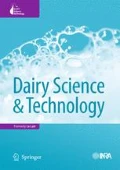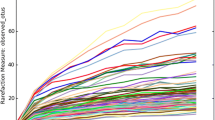Abstract
Karakačanski skakutanac is an artisanal fresh sheep cheese produced on a small scale in a limited area of eastern Croatia. It is manufactured from unrefrigerated raw sheep milk immediately after milking, without the addition of starter culture, and coagulated with industrial rennet. To date, no microbiological or molecular characterization of the biodiversity of the microbiota has been performed. The objective of this study was to obtain an initial insight into the biodiversity of the microbial community associated with this cheese during the production season and shelf life period. Eleven cheeses were obtained from a dairy farm at 14-day intervals during the lactation period of east Friesian sheep in 2007. Bacterial DNA was isolated directly from cheese on the first, second and third day of the cheese shelf life, resulting in a total of 33 DNA samples. Extracted DNA was used as a template for PCR-ARDRA and PCR-DGGE analysis. The use of dual culture-independent approaches revealed similar results and indicated predominance of Lactococcus lactis.
Abstract
Karakačanski skakutanac 14 2007 11 DNA 33 DNA DNA PCR-ARDRA PCR-DGGE (Lactococcus lactis)
Résumé
Le Karakačanski skakutanac est un fromage frais artisanal, produit à petite échelle dans une aire limitée de l’est de la Croatie. Il est fabriqué juste après la traite à partir de lait cru de brebis non réfrigéré, sans addition de levains, et coagulé par de la présure industrielle. La biodiversité de la microflore n’a jusqu’à présent jamais été caractérisée, ni par des méthodes microbiologiques classiques ni par des méthodes moléculaires. L’objectif de cette étude était d’obtenir un premier aperçu de la biodiversité de l’écosystème bactérien associé à ce type de fromage au cours de la période de production et de la durée de conservation. Onze fromages ont été collectés en 2007 d’une ferme laitière tous les 14 jours durant la période de lactation de brebis de race Frisonne. L’ADN bactérien a été isolé directement du fromage les 1er, 2e et 3e jours de stockage, donnant 33 échantillons. L’ADN extrait était utilisé pour analyse par PCR-ARDRA et PCR-DGGE. Les deux méthodes culture-indépendantes mises en œuvre ont conduit à des résultats similaires montrant la prédominance de Lactococcus lactis.
Similar content being viewed by others
References
Bonetta S., Bonetta S., Carrraro E., Rantsiou K., Cocolin L., Microbiological characterization of Robiola di Roccaverano cheese using PCR-DGGE, Food Microbiol. 25 (2008) 786–792.
Cocolin L., Manzano M., Cantoni C., Comi G., Denaturing gradient gel electrophoresis analysis of the 16S rRNA genes V1 region to monitor dynamic changes in the bacterial population during fermentation of Italian sausages, Appl. Environ. Microbiol. 67 (2001) 5113–5121.
Duthoit F., Callon C., Tessier L., Montel M.-C., Relationship between sensorial characteristics and microbial dynamics in registered designation of origin Salers cheese, Int. J. Food Microbiol. 103 (2005) 259–270.
Duthoit F., Godon J.-J., Montel M.-C., Bacterial community dynamics during production of registered designation of origin Salers cheese as evaluated by 16S rRNA gene single-strand conformation polymorphism analysis, Appl. Environ. Microbiol. 69 (2003) 3840–3848.
Ercolini D., PCR-DGGE fingerprinting: novel strategies for detection of microbes in food, J. Microbiol. Methods 56 (2004) 297–314.
Ercolini D., Hill P.J., Dodd C.E.R., Bacterial community structure and location in Stilton cheese, Appl. Environ. Microbiol. 69 (2003) 3540–3548.
Ercollini D., Moschetti G., Blaiotta G., Copola S., Behaviour of variable V3 region from 16S rDNA of lactic acid bacteria in denaturing gradient gel electrophoresis, Curr. Microbiol. 42 (2001) 199–202.
Fontana C., Vignolo G., Cocconceli P.S., PCR-DGGE analysis for the identification of microbial populations from Argentinean dry sausages, J. Microbiol. Methods 63 (2005) 254–263.
Gich F.B., Amer E., Figueras J.B., Abella C.A., Balaguer D.M., Poch M., Assessment of microbial community structure changes by amplified ribosomal DNA restriction analysis (ARDRA), Int. Microbiol. 3 (2000) 103–106.
Guthrie J., Moriarty D., Blackall L., DNA extraction from coral reef sediment for the PCR, J. Microbiol. Methods 43 (2000) 73–80.
Marino M., Maifreni M., Rondini G., Microbiological characterization of artisanal Montasio cheese, FEMS Microbiol. Lett. 229 (2003) 133–140.
Marzorati M., Wittebolle L., Boon N., Daffonchio D., Verstraete W., How to get more out of molecular fingerprints: practical tools for microbial ecology, Environ. Microbiol. 10 (2008) 1571–1581.
Muyzer G., De Wall E.C., Uitterlinden A.G., Profiling of complex microbial populations by denaturing gradient gel electrophoresis analysis of polymerase chain reaction-amplified genes coding for 16S rRNA, Appl. Environ. Microbiol. 59 (1993) 695–700.
Randazzo C.L., Caggia C., Neviani E., Application of molecular approaches to study lactic acid bacteria in artisanal cheeses, J. Microbiol. Methods 78 (2009) 1–9.
Randazzo C.L., Torriani S., Akkermans A.D.L., De Vos W.M., Vaughan E.E., Diversity, dynamics and activity of bacterial communities during production of an artisanal Sicillian cheese as evaluated by 16S rRNA analysis, Appl. Environ. Microbiol. 68 (2002) 1882–1892.
Rantsiou K., Urso R., Dolci P., Comi G., Cocolin L., Microflora of Feta cheese from Greek manufacturers, Int. J. Food Microbiol. 126 (2008) 36–42.
Rodas A., Ferrer Sergi M., Isabel P., 16S-ARDRA a tool for identification of lactic acid bacteria isolated from grape must and wine, Syst. Appl. Microbiol. 26 (2003) 412–422.
Sanguinetti C.J., Dias Neto E., Simpson A.J., Rapid silver staining and recovery of PCR products separated on polyacrylamide gels, Biotechniques 17 (1994) 914–921.
Urlik E., Rogall T., Blocker H., Emde M., Bottger E.C., Isolation and direct complete nucleotide determination of entire genes. Characterization of a gene coding for 16S ribosomal RNA, Nucl. Acid Res. 17 (1989) 7843–7853.
Author information
Authors and Affiliations
Corresponding author
About this article
Cite this article
Pogačić, T., Samaržija, D., Corich, V. et al. Microbiota of Karakačanski skakutanac, an artisanal fresh sheep cheese studied by culture-independent PCR-ARDRA and PCR-DGGE. Dairy Sci. Technol. 90, 461–468 (2010). https://doi.org/10.1051/dst/2010004
Received:
Revised:
Accepted:
Issue Date:
DOI: https://doi.org/10.1051/dst/2010004




